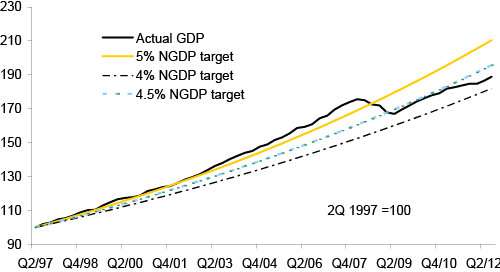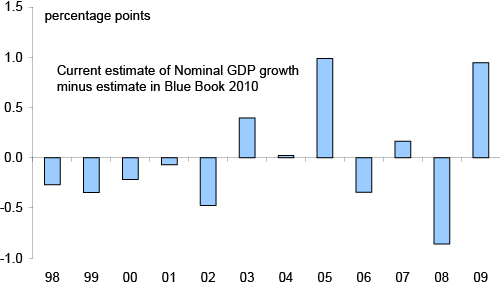The economic recovery from the 2008/9 crisis has been depressingly slow in the UK, as in many other developed countries. Further fiscal expansion is constrained by concerns about the extraordinary (for peace-time) scale of the public sector deficit and rise in the debt/GDP ratio. Hence politicians, and many other commentators, are looking to monetary policy to play an even more aggressive role in getting us out of our present stagnation.
It is in this context that particular attention has been paid by the British press, and, it would seem, the Treasury to a speech given by Mark Carney, the Governor-elect of the Bank of England, in Toronto on December 11, 2012. In this he argued that, if exceptional stimulus needed to be given, the best method could be to adopt a (temporary) target for the level of nominal GDP, whereas most other UK proponents of nominal GDP targetry, such as Sir Samuel Brittan and Lord Skidelsky, have been advocating a target for the growth rate of NGDP.
Thus, Carney stated,
| |
“If yet further stimulus were required, the policy framework itself would likely have to be changed. For example, adopting a nominal GDP (NGDP)-level target could in many respects be more powerful than employing thresholds under flexible inflation targeting. This is because doing so would add “history dependence” to monetary policy. Under NGDP targeting, bygones are not bygones and the central bank is compelled to make up for past misses on the path of nominal GDP …
However, when policy rates are stuck at the zero lower bound, there could be a more favourable case for NGDP targeting. The exceptional nature of the situation, and the magnitude of the gaps involved, could make such a policy more credible and easier to understand.
Of course, the benefits of such a regime change would have to be weighed carefully against the effectiveness of other unconventional monetary policy measures under the proven, flexible inflation-targeting framework.”
|
One of the problems of starting an NGDP target system is that the start date for ‘history’ to commence is itself entirely arbitrary. By juggling with the start date, and the desired growth path, one could leave the MPC with an immediate requirement that could vary anywhere from a huge expansion to a severe retraction. For example we show below what the implicit current gap is between the desired path for nominal GDP and the actual path for nominal GDP if history were deemed to have started in 1997 Q2, and growth paths of, say, 5% and 4% were also deemed to have been appropriate, as an upper and lower example, respectively. With the 5% path, the MPC would, assuming we aim to hit the target two years ahead, currently have to expand nominal GDP by around 10% p.a. With the 4% path, the MPC would have to keep nominal GDP growth down to around 2.3% p.a. (these estimates are based from the end of Q3 2012 to end 2014).
Figure 1 Nominal GDP under different policy scenarios
Source: ONS, Morgan Stanley Research.
Perhaps for this purpose, history will be deemed to start in July 2013 when under new management? Even if bygones remain bygones until that point, a nominal GDP level target could be much more demanding than a nominal GDP growth target.
Assume that a 5% GDP level target was set now, but that the current OBR nominal GDP growth forecast was actually achieved over the next two years. Then the shortfall from target would by then be of the order of almost 4%. With a nominal GDP level target, that shortfall has to be clawed back. Assuming that this is to be done over the next two-year horizon, then that implies a nominal GDP growth target of about 7% for each of those two years.
Effectively, any overestimation of the sustainable real rate of growth, and such overestimation is all too likely, could force an MPC, subject to a level nominal GDP target, to soon have to aim for a significantly higher rate of inflation. Is that really what is now wanted? Bring back the stagflation of the 1970s; all is forgiven?
Whether an NGDP target is to be assessed in levels or in growth format, there are two other reasons to be chary of it. First, its use would be operationally problematical. A nominal GDP target has several operational shortcomings in comparison with an inflation target. The data for CPI are available within three weeks of the end of each month. Nominal GDP data are only available quarterly, with a lag of two months from the end of the quarter. CPI data, once published, do not (normally) get revised. Whereas part of the frequently sizeable revisions to real GDP estimates is usually due to a switch between the real and inflation element of GDP. Nevertheless, nominal GDP figures themselves do become significantly revised, as shown below.
Figure 2 Nominal GDP growth is also significantly revised
Source: Morgan Stanley Research, ONS.
So, under an inflation target the MPC at least has a good idea of from where it is starting. Under a nominal GDP growth target the MPC would be flying through a current fog.
The second problem is that an NGDP target would appear to run counter to the previously accepted tenets of monetary theory. Perhaps the main claim of monetary economics, as persistently argued by Friedman, and the main reason for having an independent Central Bank, is that over the medium and longer term monetary forces influence only monetary variables. Other real (e.g. supply-side) factors determine growth; the long-run Phillips curve is vertical. Do those advocating a nominal GDP target now deny that? Do they really believe that faster inflation now will generate a faster, sustainable, medium- and longer-term growth rate?
If we knew what the future sustainable long-run rate of growth would be, we could set a current nominal GDP growth target that would on average deliver that, plus 2% inflation. But we do not. Moreover, the view is steadily gaining ground that it is more likely, than not, that real growth in the future will be below the average of past decades; technological innovation may slow and demographic developments will be adverse. So, if we wanted to maintain price level stability, with inflation at 2%, we should be considering a nominal GDP growth target of slightly under 4%. That is not what the advocates of such a target propose.
Given our uncertainty about sustainable growth, an NGDP target also has the obvious disadvantage that future certainty about inflation becomes much less than under an inflation (or price level) target. In order to estimate medium- and longer-term inflation rates, one has first to take some view about the likely sustainable trends in future real output. The latter is very difficult to do at the best of times, and the present is not the best of times. So shifting from an inflation to a nominal GDP growth target is likely to have the effect of raising uncertainty about future inflation and weakening the anchoring effect on expectations of the inflation target.
Conclusion
If we thought that we had learnt anything from the travails of the 1960s and 1970s, it was that monetary expansion in the medium and longer run does not bring faster, sustainable growth. If anything, the opposite is true; faster inflation, at any rate beyond some threshold, deters growth. The long-run Phillips curve is vertical. It was on this analytical basis that the case both for Central Bank independence and a specific inflation target was made.
Editors' note: Copyright 2013 Morgan Stanley. Please note that materials that are referenced here are intended for informational use only, so please do not forward the content contained herein. If you should have a need to use/share the materials externally, please send an email to [email protected]. Additionally, MS and VoxEU.org have provided their materials here either through agreement or as a courtesy. Therefore, MS and VoxEU.org do not undertake to advise you of changes in the opinions or information set forth in these materials. You should note the date.
Authors' note: This article is based on research published for Morgan Stanley Research on January 9, 2013. It is not an offer to buy or sell any security/instruments or to participate in a trading strategy. For important disclosures as of the date of the publication of the research, please refer to the original piece available at Monetary Targetry: Possible Changes under Carney. For important current disclosures that pertain to Morgan Stanley, please refer to the disclosures regarding the issuer(s) that are the subject of this article on Morgan Stanley’s disclosure website. https://www.morganstanley.com/researchdisclosures. Charles Goodhart is a senior adviser to Morgan Stanley. In his personal capacity, Mr. Goodhart advises other organizations and firms on economic matters, including among others, the Financial Markets Group of the London School of Economics.







